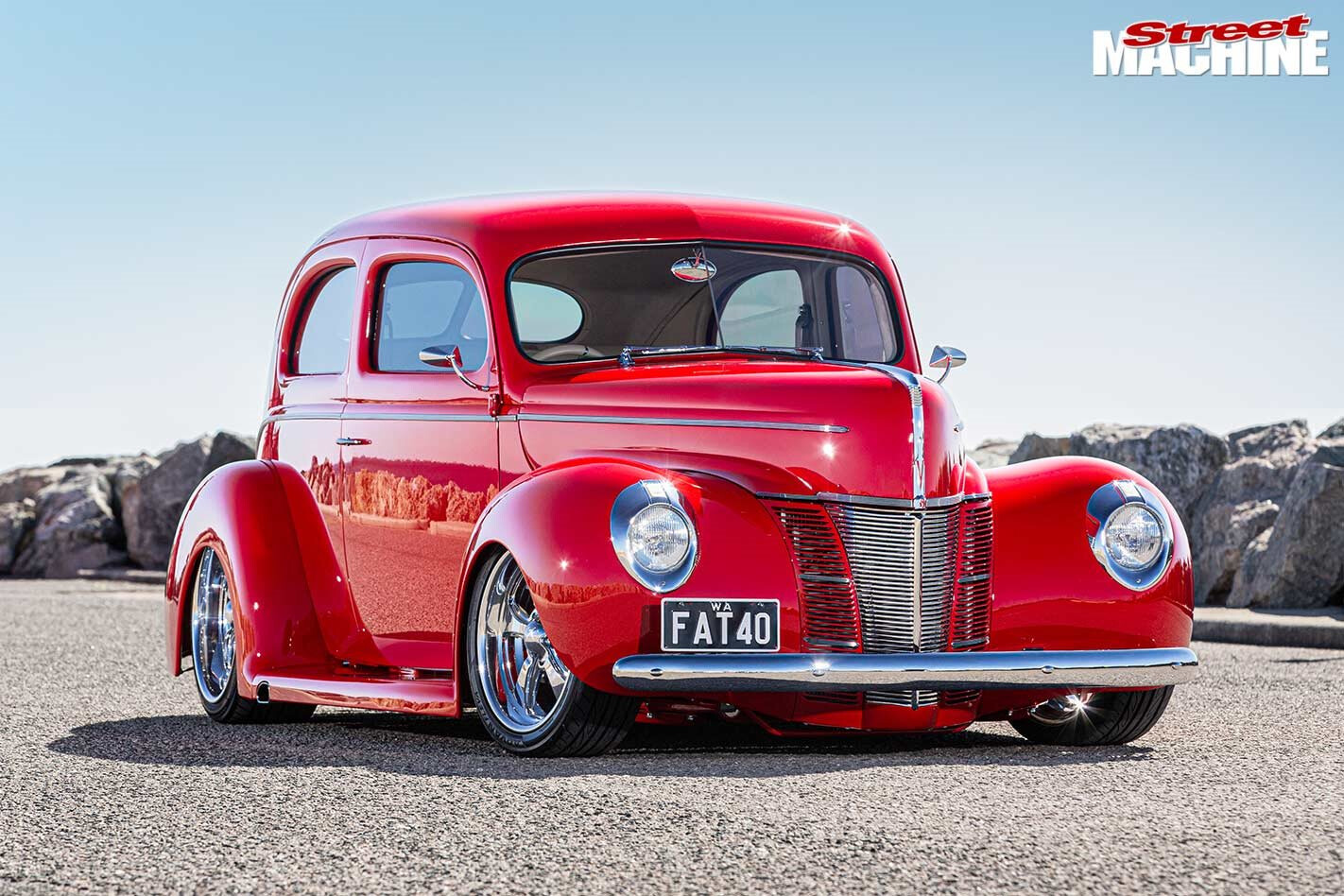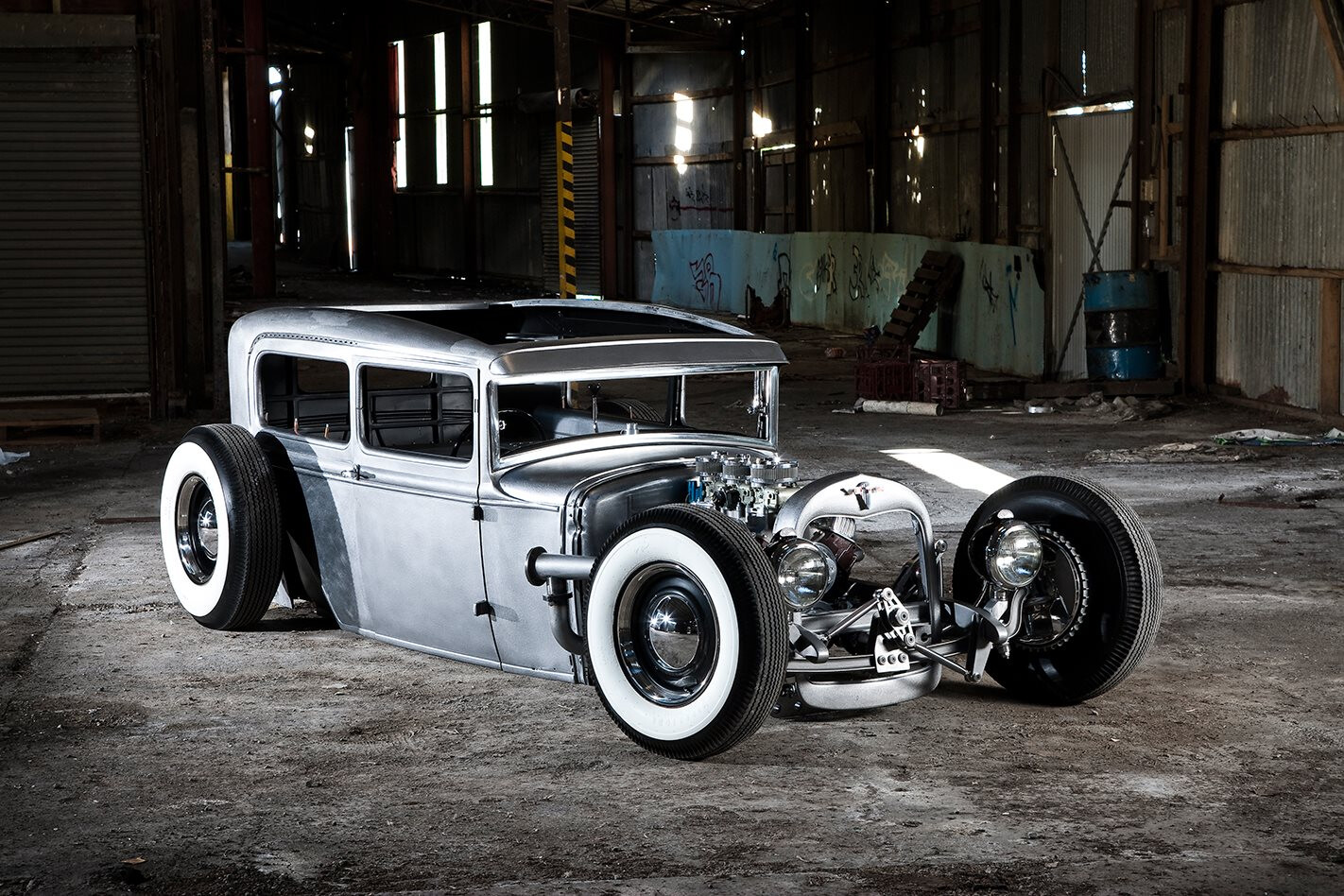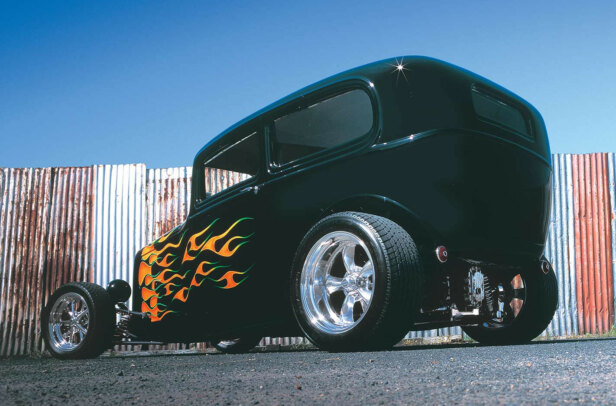I FIRST spotted Mark Celenza’s ’40 tudor as it rolled onto the oval at the Cranksters Hot Summer Nights show ’n’ shine. To my mind, it could have rolled right off the pages of an American hot rod magazine – or perhaps out of a shipping container – but on closer inspection, I spotted the right-hand drive dashboard and was soon informed that it was locally built. That made my decision to feature it in SM Hot Rod even easier.
This article was first published in Street Machine’s Hot Rod magazine #20, 2019
While most cars of the late 30s and early 40s are known generally as fat-fendered cars, Mark’s ’40 lives up to the name even more with two inches added to the width of each fender
One of the reasons I initially thought Mark’s airbagged and LS-powered ’40 may have been an import was because of the tudor body style. We had two-door sedans here, but they were the uniquely Australian sloper body style; a hybrid coupe/sedan that most of the local manufacturers offered in the late 30s. That wasn’t the case with Mark’s car – it was the US version and had already been brought into the country as an unmolested original when Mark spotted it for sale.
Australia had our own unique version of a two-door – or tudor – sedan known as a “sloper”, but Mark’s car is the US-bodied version
“A guy by the name of Ian Cornell in Melbourne brought it in,” says Mark. “I was looking at the time and looked at a ’36 four-door sedan, then the ’40 came up, and I’ve always liked the two-door. I remember when I was building my T-bucket over 25 years ago, there was a black tudor in America built by Tom Vogel for Jerry Moreland. It was the world’s quickest street rod at the time. That’s why I liked the body style, and I wanted to build something different.”
The side-exit exhausts are functional and meant Mark didn’t have to try and weave his way through the Jag IRS
This isn’t Mark’s first build, but it was a long time between drinks, with the T-bucket sold not long after he finished it. It’s living a happy life in South Australia these days and is mostly unchanged – a testament to the quality of the cars Mark builds. He admits the tudor build took a bit longer than planned, but life sometimes gets in the way.
“I got the car in 2008, so it took 10 years, but it sat for three years while we built the house and I didn’t do a thing to it.”
That killer stance is achieved through airbags fitted to the Series III Jag front and rear ends
Mark did manage to get about three years’ worth of work done before the hiatus. First off, the car was pulled apart and sandblasted so that Steve Houlahan could work his magic on it.
“Steve did all the fabrication work, but he wanted everything clean, so I had to pull apart the Jag front and rear ends, sandblast them and put it all back together,” says Mark. “I had to undo the centre crossmember off the two rails, so I had to drill out about 96 rivets.”
Steve then got busy fabricating the tubular crossmember and boxing in the chassis as well as putting in a new firewall and floor.
The reversing camera is mounted to the number plate and displays on a screen mounted in the bulkhead under the dash
The outside bodywork was handled by Ed Parker, who got it looking sharp for the Sting Red paintjob applied by Charlie Takacs. It’s pretty much restored, with all of the original jewellery and trim still in place. In fact, the car has all of its original sheet metal and about 80 per cent of the stainless trim is original to the car. Where Ed spent a lot of time was on the fenders, adding two inches to the width on each side. It’s a subtle but effective modification that has to be pointed out to the observer – a sure sign that it was done right. As well as giving the car a fatter and lower look, it was key to fitting the Jag suspension to the front and rear.
“That’s why we widened the guards, and we put a Hoppers Stoppers brake kit on it to narrow the track to get the wheels tucked in so I could get it to turn at that ride height,” says Mark.
It’s no secret that I’m a fan of more traditionally styled hot rods, but what I really appreciate are cars that are built with a cohesive design – those that follow a theme and stick to it – and that’s exactly what Mark’s tudor does. It’s built as a comfortable cruiser with all the mod cons.
The car is as tidy underneath as it is on top, with the underside of the body finished in tinted Raptor liner and everything else wearing the same Sting Red as the topside
“The engine is a brand new 6.0-litre crate motor,” says Mark. “Jamie Staltari has done a bit of a tune to make it sound more like a hot rod, but it’s standard.”
Even more proof that it’s built as a cruiser is the column shift auto, something you hardly ever see on Aussie hot rods.
The engine bay is clean and simple, with the body colour extended to the engine covers. Underneath lies a standard L76 6.0-litre, which is backed by a 4L65E four-speed auto
“I didn’t want anything on the floor. My style of driving is, put it in Drive and leave it there,” says Mark.
Other creature comforts include power rack-and-pinion steering, Vintage Air a/c, hidden stereo system, electric power seats and cruise control! It’s just like a new car, only a thousand times cooler.
While the interior has been updated with Volvo C70 seats front and rear, and the door panels feature a swoopy embossed pattern, Mark still wanted to look out across a ’40 Ford dash.
Mark found an original RHD ’40 dash and colour-matched the satin paint finish to the leather trim. The window garnish mouldings got the same treatmen
“I wanted the dash to look fairly stock, just the speaker grille and four knobs, but we did delete the ashtrays. I’ve even used the original handbrake and when we pulled the car apart, there are actually two mounting holes underneath the dash on the right-hand side, even though it’s an American car.”
The gauges are a one-off design from Classic Instruments.
The stylishly modern interior trim was handled by Trimcare and features Volvo C70 seats front and rear
“I don’t like the Deluxe panels because they have a plastic cover that sits proud of the dash, so I bought a Standard panel off eBay and posted it direct to Classic Instruments,” Mark explains. “They came back to me with a couple of designs. I got it done in kilometres per hour and there’s a little tacho in the centre of the speedo.”
Keeping with the modern theme, the rolling stock is suitably sized, with 18x7s up front and 20x10s out back fitted with Yokohama 215/45 and 275/35 rubber, respectively. The Billet Specialties rims are a simple and elegant five-spoke design, which pretty much sums up the whole build philosophy of the car.
A Billet Specialties “Waterfall” steering wheel ties in nicely with the interior, and the gauge panel and clock are one-offs from Classic Instruments. The gauges are based on the Standard and not Deluxe panel as Mark preferred the look
By no means am I implying that this was a simple build. There are a lot of very clever touches throughout the car, but they’ve been done so well that they don’t stand out. Mark’s a pretty low-key guy and doesn’t go chasing the limelight, but still, you can see this car coming from a mile away. Even from that distance, you can tell it’s built with quality and an impeccable eye for detail. Being the centre of attention is something Mark might have to become a little more accustomed to.
MARK & KERYN CELENZA
1940 FORD TUDOR
Paint: Sting Red
DONK
Type: L76 6.0-litre
Valves: 2.165in (in), 1.590in (ex)
Radiator: Griffin
Exhaust: Polished stainless 2.5in, 100 flow cats, SMB mufflers
SHIFT
’Box: GM 4L65E
Converter: Standard
Diff: Jag Series III, 3.30:1 gears
BENEATH
Front end: Jag Series III, 6in Slam Specialties airbags
Rear end: Jag Series III
Shocks: Early VW (f), ShockWave airbags (r)
Steering: Jag power rack-and-pinion
Brakes: Hoppers Stoppers 300mm (f), Jag inboard discs (r)
ROLLING STOCK
Rims: Billet Specialties SLG60; 18×7 (f), 20×10 (r)
Rubber: Yokohama ADVAN Fleva; 215/45R18 (f), 275/35/R20 (r)
THANKS
Keryn and my four girls (three daughters and Rosie the Labrador) for their help; Steve Houlahan for all his help with the fabrication work and more; Ed Parker for body mods and preparation for paint and reassembly of panels after paint; Chris at Trimcare for the interior trim; Riverton Auto Electrics for stage one of wiring (car was completely wired before panel and paint); Rory Smith for stage two wiring, putting it all back in at my place; Jamie Staltari for setting up the computers for motor and trans, cruise control, calibrating speedo and sorting lots of other misc. gremlins; Willy Thompson at TT Auto for all his help and advice on numerous mechanical issues; Competition and Industrial Coatings at Welshpool for polishing and ceramic-coating parts; Jeff Garland at Garland Custom Fabrication; Sam Hawkins at Awesam Paintworks for the engine covers, manifold and throttlebody paint, and repainting the hood and running boards due to owner mishaps; and Dom at Prestige Exhaust




Comments